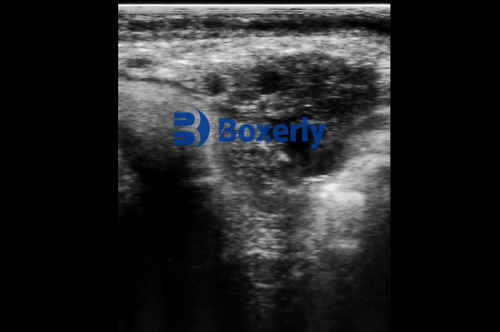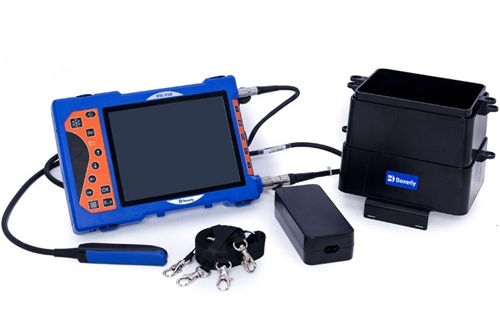As a small ruminant farmer, grasping precise gestation stages in goats is pivotal for maximizing productivity, ensuring animal welfare, and making well-timed nutritional and management decisions. Among the many tools at our disposal, transabdominal ultrasound is one of the most reliable, ไม่รุกราน, and informative methods for assessing pregnancy progress, fetal viability, and placental health in goats. ในบทความนี้, I’ll explore how goat—use ultrasound tools like BXL‑V50 to guide nutritional strategies, improve kidding outcomes, and optimize overall herd performance.

1. The Importance of Precise Gestational Staging
1.1 Understanding Gestation Phases in Goats
Goat gestation typically spans around 150 วัน, roughly five months. This period can be subdivided into three critical stages:
-
Early gestation (Days 1–50): Embryo formation, early organogenesis.
-
Mid gestation (Days 51–100): Rapid fetal growth and skeletal development.
-
Late gestation (Days 101–150): Intensive fetal mass increase and mammary preparation.
Recognizing exactly where each doe falls in this timeline allows farmers to tailor nutrition, vaccination timing, and stress management accordingly.
1.2 Why Accurate Dating Matters
Incorrect estimation risks either underfeeding, which stunts fetal growth, or overfeeding, leading to metabolic disorders like pregnancy toxemia. Efficiently using feed based on ultrasound staging ensures economic and health benefits.
2. Ultrasound in Goat Reproduction: A Valuable Tool for Global Farmers
2.1 International Practices
Farmers across the EU and North America increasingly rely on ultrasound due to its accuracy and affordability:
-
In New Zealand, dairy goat operations use ultrasound at 40–60 days to determine litter size (single, twin, triplet), which informs feed ration changes.
-
In France and Germany, veterinarians regularly scan does at 90 days to assess placentome health, a strong indicator of placental function and fetal well-being.
The universal advantage is early intervention: if a doe shows signs of compromised placental function, nutritional changes or veterinary care can be deployed well before kidding.

3. Introducing the BXL‑V50: A Modern Ultrasound Asset
3.1 What Is the BXL‑V50?
พื้นที่ BXL‑V50 is a compact, portable B‑mode ultrasound device designed for livestock. Highlights include:
-
Lightweight, rugged construction—ideal for outdoor farm use.
-
5.0 MHz convex transducer—optimal for small ruminant deep scanning.
-
Real‑time imaging with clear fetal detail.
-
Integrated measurement tools (crown‑rump length, biparietal diameter).
-
USB battery with 5–8 hours runtime.
-
Cost‑effective—comparable to or lower than desktop equivalents.
3.2 Field Use in Goat Herds
On my farm, I began using the BXL‑V50 during kidding 2024:
-
Day 30–40: early confirmation of pregnancy.
-
Day 60–70: litter size and general health.
-
Day 90–100: fetal growth rate and placental integrity.
-
Day 120–140: fetal position and size for kidding planning.
This device helped us precisely tailor feed energy, helping triplet-bearing does avoid negative energy balance in late gestation. It also drove adjustments in stocking density and shelter for at-risk pregnancies.
4. Nutritional Strategies Based on Ultrasound Findings
4.1 Early Gestation: Embryonic Needs
Fertilization through implantation consumes relatively little energy, but needs specific micronutrient support. Early ultrasound confirmation allows for targeted micronutrient supplementation (e.g., selenium, vitamin E) without increasing bulk feed.
4.2 Mid Gestation: Focus on Fetal Development
Once litter size is known, feed can be divided:
| Litter Size | Daily MBW% | Strategy |
|---|---|---|
| Single | 2.0% | Baseline maintenance plus fetal support |
| Twins | 2.3–2.5% | 10–15% feed increase over singles |
| Triplets+ | 2.7–3.0% | Higher energy + protein focus |
Ultrasound at day 60–70 confirms litter size, enabling proper planning. Overfeeding during mid gestation is avoided, protecting against excess fat deposition and metabolic stress.
4.3 Late Gestation: Critical Window
Days 100–150 see exponential fetal weight gains—around 70% of total. Here, feed is stepped up to 3.5–4.0% of metabolic body weight daily. Ultrasound informs:
-
Signs of fetal crowding or low amniotic fluid → veterinary/corrective action.
-
Estimating fetal weight from biparietal diameter → adjust energy accordingly.
-
Fetal posture → determines whether natural birthing can proceed or caesarean is advisable.
4.4 Post‑kidding: Recovery and Lactation
Ultrasound may still help postpartum: assessing uterine involution, ovarian function, and milk‑line tissue development around 30 days postpartum ensures does are ready for rebreeding, and helps in lactation nutrition planning.
5. Real‑World Example: My Farm Case Study
5.1 Overview
-
Herd: Alpine × Saanen cross; ~60 does.
-
Goals: higher kid survival, better uniformity, reduced feed cost, precise metabolic health control.
-
เครื่อง มือ: BXL‑V50 portable ultrasound; monthly body condition scoring.
5.2 Gestation Monitoring Protocol
-
Day 30: confirm pregnancy, cull empty does.
-
Day 60: assess litter size; categorize does and assign feed group.
-
Day 90–100: check fetal development, placental health; adjust minerals.
-
Day 120: evaluate fetal size/position; plan kidding paddocks.
5.3 Achievements
-
Kidding mortality dropped from ~8% to ~3%.
-
Average birth weight increased 8%, with more uniform triplet size.
-
Feed cost per kid reduced 12% due to no overfeeding.
-
Metabolic disorders fell from ~5% of does to ~1%.
Ultrasound, and especially BXL‑V50, empowered data‑driven nutrition and management—yielded efficiency and health gains.
6. What Foreign Studies Say
6.1 สหรัฐอเมริกา
A 2023 Penn State study confirmed ultrasound as accurate for litter size determination at 45–60 days in Boer goats, กับ >95% ความถูกต้อง. This allowed early feed ration adjustments for twin/triplet does, significantly reducing pregnancy toxemia.
6.2 Europe
A Spanish study (2022) using ultrasound to measure biparietal diameter on Spanish Murciano‑Granadina goats found a strong correlation (R² = 0.92) with birth weight. Veterinarians in Spain now recommend scans at day 100–110 to predict kid weight and set lactation feeding levels.
6.3 New Zealand
Routine ultrasound scanning in pastoral systems at 60 days is widespread. Kiwi researchers emphasized the link between adequate feeding based on litter size and improved milk yield and kid growth—particularly critical in the peak pasture season.
7. Ultrasound Benefits Beyond Nutrition
7.1 Pregnancy Confirmation & Early Culling
Empty does are identified early and returned to reproductive prep, skipping feed load for non‑productive animals.
7.2 Placental and Maternal Health
Scanning placentomes and amniotic fluid helps detect poor placental function, allowing immediate veterinary care or nutritional/paddock changes.
7.3 Fetal Well‑Being & Birth Planning
By assessing fetal size and position pre‑kidding, decisions about kidding paddock, assistance, or caesarean become precise and timely.
7.4 Research, Genetic Selection and Record‑Keeping
Ultrasound data supports production records, enabling effective sire selection, breeding decisions, and farm benchmarking.
8. Practical Tips for Ultrasound Use
-
Training: Basic ultrasound skills are easily learned via workshops or online modules.
-
Gentle preparation: Shave or trim hair, clean the flank; sond gel improves image quality.
-
Scan speed: Keep does calm—use forage or lighting soft music.
-
Measurements: Note crown‑rump, biparietal diameter, placentome count, fluid depth.
-
เอกสาร: Record all readings. Software or paper logs enable tracing fetus/doe performance.
9. Overcoming Challenges
-
Upfront cost: Device cost is recouped via improved output.
-
Learning curve: Initial investment in training pays off in long‑term efficiency.
-
Field environment: BXL‑V50 is rugged; care for probe and device to extend lifetime.
-
Body size variation: Breed differences exist; calibrate expected ultrasound values per breed.
10. Future Directions in Goat Ultrasound Nutrition
-
Portable AI analysis: Upcoming software that auto‑reads litter size, growth curves, fluid volumes.
-
Integration with sensors: Linking ultrasound with weight‑scales and feed intake monitors for holistic data.
-
Tele‑veterinary support: Remote scanning by AI or vets aiding small producers in remote regions.
11. บทสรุป
From overseas experiences in New Zealand pastures to European dairy operations, ultrasound is transforming goat reproduction and feeding efficiency. Devices like BXL‑V50 are practical, accurate, cost‑effective additions to any goat farm. Tailoring nutrition to pregnancy stage, ขนาดครอก, and fetal wellbeing reduces waste, boosts survival, and elevates animal health.
By embracing ultrasound monitoring, fodder use becomes smarter, metabolic breakdowns are avoided, and kidding becomes more predictable. Moving forward, AI‑assisted analytics and data integration will make this process even more efficient and accessible to all goat producers.
References
-
Schillo, K. (2023). Small Ruminant Reproductive Ultrasound – Techniques and Applications. Penn State Extension. https://extension.psu.edu/small-ruminant-reproductive-ultrasound
-
Pérez‑Sánchez, F. et al. (2022). “Biparietal diameter and birth weight in Murciano‑Granadina goats.” Small Ruminant Research. https://doi.org/10.1016/j.smallrumres.2022.106475
-
McDonald, L. (2022). Using ultrasound in pastoral goat systems. Dairy Goat Association of New Zealand. https://dganewzealand.org.nz/ultrasound-guide
-
GoatTech. (2024). BXL‑V50 Veterinary Ultrasound Manual. http://goattechnology.com/manuals/bxl‑v50‑manual.pdf
